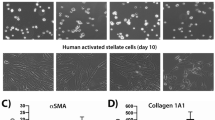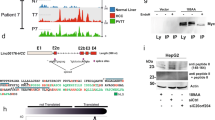Abstract
Tumor markers can facilitate understanding molecular cell biology of neoplasia and provide potential targets for the diagnosis and insight for intervention. We here identify a novel murine gene, hepcarcin (hcn), encoding a 7-kb mRNA-like transcript. The gene appears to be the murine ortholog of the human alpha gene, that is, MALAT-1. The gene and homologs lack credible open reading frames, consistent with a highly conserved large noncoding RNA (ncRNA). In all nodules of procarcinogen-induced murine hepatocellular carcinomas (HCCs) and human HCCs, expression was markedly elevated compared to the uninvolved liver. Quantitative analyses indicated a 6–7-fold increased RNA level in HCCs versus uninvolved liver, advancing this as a molecule of interest. This ncRNA was overexpressed in all five non-hepatic human carcinomas analysed, consistent with a potential marker for neoplastic cells and potential participant in the molecular cell biology of neoplasia.
This is a preview of subscription content, access via your institution
Access options
Subscribe to this journal
Receive 50 print issues and online access
$259.00 per year
only $5.18 per issue
Buy this article
- Purchase on Springer Link
- Instant access to full article PDF
Prices may be subject to local taxes which are calculated during checkout





Similar content being viewed by others
References
Bartel DP . (2004). MicroRNAs: genomics, biogenesis, mechanism, and function. Cell 116: 281–297.
Bass BL . (2002). RNA editing by adenosine deaminases that act on RNA. Annu Rev Biochem 71: 817–846.
Brockdorff N, Ashworth A, Kay GF, McCabe VM, Norris DP, Cooper PJ et al. (1992). The product of the mouse Xist gene is a 15 kb inactive X-specific transcript containing no conserved ORF and located in the nucleus. Cell 71: 515–526.
Brown CJ, Hendrich BD, Rupert JL, Lafreniere RG, Xing Y, Lawrence J et al. (1992). The human XIST gene: analysis of a 17 kb inactive X-specific RNA that contains conserved repeats and is highly localized within the nucleus. Cell 71: 527–542.
Carninci P, Kasukawa T, Katayama S, Gough J, Frith MC, Maeda N et al. (2005). The transcriptional landscape of the mammalian genome. Science 309: 1559–1563.
Davis IJ, Hsi BL, Arroyo JD, Vargas SO, Yeh YA, Motyckova G et al. (2003). Cloning of an Alpha-TFEB fusion in renal tumors harboring the t(6;11)(p21;q13) chromosome translocation. Proc Natl Acad Sci USA 100: 6051–6056.
Eddy SR . (2001). Non-coding RNA genes and the modern RNA world. Nat Rev Genet 2: 919–929.
Eferl R, Ricci R, Kenner L, Zenz R, David JP, Rath M et al. (2003). Liver tumor development. c-Jun antagonizes the proapoptotic activity of p53. Cell 112: 181–192.
Erdmann VA, Barciszewska MZ, Szymanski M, Hochberg A, de Groot N, Barciszewski J . (2001). The non-coding RNAs as riboregulators. Nucleic Acids Res 29: 189–193.
Ji P, Diederichs S, Wang W, Boing S, Metzger R, Schneider PM et al. (2003). MALAT-1, a novel noncoding RNA, and thymosin beta4 predict metastasis and survival in early-stage non-small cell lung cancer. Oncogene 22: 8031–8041.
Kalinichenko VV, Major ML, Wang X, Petrovic V, Kuechle J, Yoder HM et al. (2004). Foxm1b transcription factor is essential for development of hepatocellular carcinomas and is negatively regulated by the p19ARF tumor suppressor. Genes Dev 18: 830–850.
Kuiper RP, Schepens M, Thijssen J, van Asseldonk M, van den BE, Bridge J et al. (2003). Upregulation of the transcription factor TFEB in t(6;11)(p21;q13)-positive renal cell carcinomas due to promoter substitution. Hum Mol Genet 12: 1661–1669.
Lanz RB, McKenna NJ, Onate SA, Albrecht U, Wong J, Tsai SY et al. (1999). A steroid receptor coactivator, SRA, functions as an RNA and is present in an SRC-1 complex. Cell 97: 17–27.
Lottin S, Adriaenssens E, Dupressoir T, Berteaux N, Montpellier C, Coll J et al. (2002). Overexpression of an ectopic H19 gene enhances the tumorigenic properties of breast cancer cells. Carcinogenesis 23: 1885–1895.
Lu J, Getz G, Miska EA, Alvarez-Saavedra E, Lamb J, Peck D et al. (2005). MicroRNA expression profiles classify human cancers. Nature 435: 834–838.
Maeda S, Kamata H, Luo JL, Leffert H, Karin M . (2005). IKKbeta couples hepatocyte death to cytokine-driven compensatory proliferation that promotes chemical hepatocarcinogenesis. Cell 121: 977–990.
Manoharan H, Babcock K, Willi J, Pitot HC . (2003). Biallelic expression of the H19 gene during spontaneous hepatocarcinogenesis in the albumin SV40 T antigen transgenic rat. Mol Carcinogen 38: 40–47.
Meltzer PS . (2005). Cancer genomics: small RNAs with big impacts. Nature 435: 745–746.
Numata K, Kanai A, Saito R, Kondo S, Adachi J, Wilming LG et al. (2003). Identification of putative noncoding RNAs among the RIKEN mouse full-length cDNA collection. Genome Res 13: 1301–1306.
O'neill MJ . (2005). The influence of non-coding RNAs on allele-specific gene expression in mammals. Hum Mol Genet 14 (Spec No 1): R113–R120.
Okazaki Y, Furuno M, Kasukawa T, Adachi J, Bono H, Kondo S et al. (2002). Analysis of the mouse transcriptome based on functional annotation of 60 770 full-length cDNAs. Nature 420: 563–573.
Ota T, Suzuki Y, Nishikawa T, Otsuki T, Sugiyama T, Irie R et al. (2004). Complete sequencing and characterization of 21 243 full-length human cDNAs. Nat Genet 36: 40–45.
Plath K, Mlynarczyk-Evans S, Nusinow DA, Panning B . (2002). Xist RNA and the mechanism of X chromosome inactivation. Annu Rev Genet 36: 233–278.
Prasanth KV, Prasanth SG, Xuan Z, Hearn S, Freier SM, Bennett CF et al. (2005). Regulating gene expression through RNA nuclear retention. Cell 123: 249–263.
Ramaswamy S, Tamayo P, Rifkin R, Mukherjee S, Yeang CH, Angelo M et al. (2001). Multiclass cancer diagnosis using tumor gene expression signatures. Proc Natl Acad Sci USA 98: 15149–15154.
Reis EM, Nakaya HI, Louro R, Canavez FC, Flatschart AV, Almeida GT et al. (2004). Antisense intronic non-coding RNA levels correlate to the degree of tumor differentiation in prostate cancer. Oncogene 23: 6684–6692.
Sarma DS, Rao PM, Rajalakshmi S . (1986). Liver tumour promotion by chemicals: models and mechanisms. Cancer Surv 5: 781–798.
Scherer SW, Cheung J, MacDonald JR, Osborne LR, Nakabayashi K, Herbrick JA et al. (2003). Human chromosome 7: DNA sequence and biology. Science 300: 767–772.
Steenman MJ, Rainier S, Dobry CJ, Grundy P, Horon IL, Feinberg AP . (1994). Loss of imprinting of IGF2 is linked to reduced expression and abnormal methylation of H19 in Wilms' tumour. Nat Genet 7: 433–439.
van Asseldonk M, Schepens M, de Bruijn D, Janssen B, Merkx G, Geurts vK . (2000). Construction of a 350-kb sequence-ready 11q13 cosmid contig encompassing the markers D11S4933 and D11S546: mapping of 11 genes and 3 tumor-associated translocation breakpoints. Genomics 66: 35–42.
Volinia S, Calin GA, Liu CG, Ambs S, Cimmino A, Petrocca F et al. (2006). A microRNA expression signature of human solid tumors defines cancer gene targets. Proc Natl Acad Sci USA 103: 2257–2261.
Willingham AT, Orth AP, Batalov S, Peters EC, Wen BG, Aza-Blanc P et al. (2005). A strategy for probing the function of noncoding RNAs finds a repressor of NFAT. Science 309: 1570–1573.
Xu L, Hui L, Wang S, Gong J, Jin Y, Wang Y et al. (2001a). Expression profiling suggested a regulatory role of liver-enriched transcription factors in human hepatocellular carcinoma. Cancer Res 61: 3176–3181.
Xu XR, Huang J, Xu ZG, Qian BZ, Zhu ZD, Yan Q et al. (2001b). Insight into hepatocellular carcinogenesis at transcriptome level by comparing gene expression profiles of hepatocellular carcinoma with those of corresponding noncancerous liver. Proc Natl Acad Sci USA 98: 15089–15094.
Yamada K, Kano J, Tsunoda H, Yoshikawa H, Okubo C, Ishiyama T et al. (2006). Phenotypic characterization of endometrial stromal sarcoma of the uterus. Cancer Sci 97: 106–112.
Yan MD, Hong CC, Lai GM, Cheng AL, Lin YW, Chuang SE . (2005). Identification and characterization of a novel gene Saf transcribed from the opposite strand of Fas. Hum Mol Genet 14: 1465–1474.
Acknowledgements
We thank Drs Paul Schimmel, Frank Chisari and Peiqing Sun for critical discussions about the manuscript, Dr Carolin Lanigan for assistance in statistics and Barbara Parker, Elizabeth M Boyd and Dr Jasimuddin Ahamed for assistance and manuscript preparation. This study was funded by NIH NHLBI Program Project HL-16411 and NIH NCI training Grant CA-75924. Sequence data of hepcarcin have been deposited to GenBank under accession number AY722410. RL wishes to dedicate this paper to his father, Mr Lin Zhigao, who had fought against cancer courageously and faded away at age 47 on 1984-10-9.
Author information
Authors and Affiliations
Corresponding authors
Additional information
Supplementary Information accompanies the paper on oncogene website (http://www.nature.com/onc).
Supplementary information
Rights and permissions
About this article
Cite this article
Lin, R., Maeda, S., Liu, C. et al. A large noncoding RNA is a marker for murine hepatocellular carcinomas and a spectrum of human carcinomas. Oncogene 26, 851–858 (2007). https://doi.org/10.1038/sj.onc.1209846
Received:
Revised:
Accepted:
Published:
Issue Date:
DOI: https://doi.org/10.1038/sj.onc.1209846
Keywords
This article is cited by
-
GM-lncLoc: LncRNAs subcellular localization prediction based on graph neural network with meta-learning
BMC Genomics (2023)
-
LINC00478-derived novel cytoplasmic lncRNA LacRNA stabilizes PHB2 and suppresses breast cancer metastasis via repressing MYC targets
Journal of Translational Medicine (2023)
-
Long non-coding RNA CCL14-AS suppresses invasiveness and lymph node metastasis of colorectal cancer cells by regulating MEP1A
Cancer Cell International (2023)
-
LncRNA FBXL19-AS1 promotes proliferation and metastasis of cervical cancer through upregulating COL1A1 as a sponge of miR-193a-5p
Journal of Biological Research-Thessaloniki (2021)
-
Long non-coding RNA MALAT1 regulates oxaliplatin-resistance via miR-324-3p/ADAM17 axis in colorectal cancer cells
Cancer Cell International (2020)



